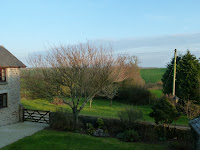There was a somewhat turbulent start to Spring in my part of Cornwall with about three or four days of lovely, warm, clear, sunny weather closely followed by a thick fog that didn't lift for five days. Now though, we finally seem to back on track, and nature has embraced this second chance of new beginnings.The daffodils have long been out, primoses are flowering, and the crops are rising out of the fields around us.
Outside my bedroom window the birds have (finally) taken to my feeder, and a pair of house sparrows are nesting in the guttering above my room (I daren't tell my father). Each morning, I am now awakened by glorious sunshine, with the view of sparrows, greenfinches, blue tits and great tits feeding about 2m away from me. The nesting sparrow pair are also constantly passing by my window with twigs and nesting material (all the while, driving my cat crazy with the apparent injustice of the window pane!).

 This is not the only sign of nature 'settling down' for the upcoming season to have reached my attention. I was at the rural cottages my parents own today (http://www.tucoyse.co.uk/), and in one of the upstairs windows, the jackdaws have unwittingly set their nest in a location offering a prime view to our visitors (photo). It remains to be seen whether or not they will abandon this nest upon realisation that their secluded nest site is actually in the bedroom of a busy holiday cottage!
This is not the only sign of nature 'settling down' for the upcoming season to have reached my attention. I was at the rural cottages my parents own today (http://www.tucoyse.co.uk/), and in one of the upstairs windows, the jackdaws have unwittingly set their nest in a location offering a prime view to our visitors (photo). It remains to be seen whether or not they will abandon this nest upon realisation that their secluded nest site is actually in the bedroom of a busy holiday cottage!
I'm due to put dormouse nest boxes out at Golitha Falls, a National Nature Reserve (NNR) in two weeks, and am spending tomorrow making some to put out on Goss Moor (another NNR). These boxes are also in anticipation of the upcoming breeding season, and are used by the dormice in the summer to sleep and breed.
We had two hen pheasants wander around the garden a few days ago. Their mission was to investigate every nook and cranny of the garden for potential nest sights. They even tested a few potential sites by sitting down in every which-way possible before deciding that no, this garden is not a suitable location. Although camouflaged within the undergrowth, a hen must choose a site that offers sufficient brood rearing habitat nearby for her chicks. Once hatched, they must eat a very high protein diet for the first few days, a diet they obtain from a vast number of invertebrates- this was what I suspect was lacking from our garden.
Thanks,
Becky




